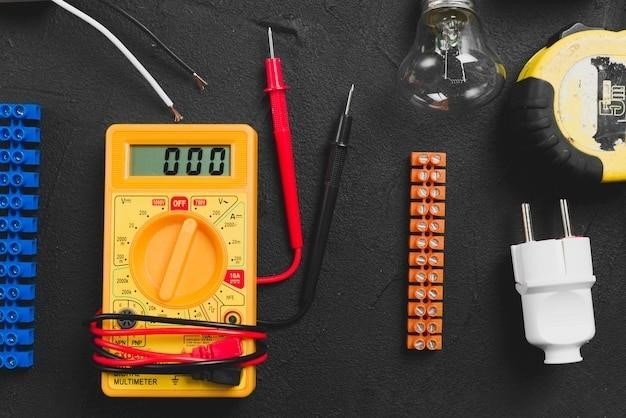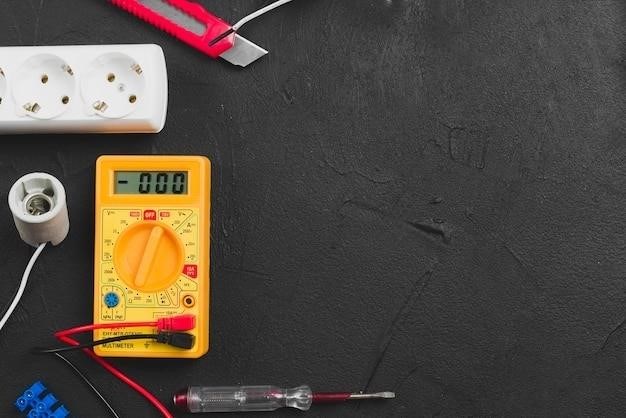This manual provides comprehensive instructions for using and maintaining a 7 Function Digital Multimeter. It covers safety precautions, product overview, specifications, functions, and troubleshooting tips; The manual is designed to guide users through various measurement techniques, including voltage, current, resistance, diode and transistor testing, and battery test. It also includes information on warranty and maintenance procedures.
Introduction
Welcome to the world of electronics troubleshooting with the 7 Function Digital Multimeter! This versatile tool, often referred to as a DMM, is an essential companion for anyone working with electrical circuits. Whether you’re a seasoned professional or a curious hobbyist, understanding the capabilities and proper usage of your DMM is crucial for accurate measurements, safe operation, and successful projects. This manual will serve as your guide, providing detailed information on each function, safety precautions, and troubleshooting tips to ensure you get the most out of your 7 Function Digital Multimeter.
Safety Precautions
Always prioritize safety when working with electrical circuits and your 7 Function Digital Multimeter. Here are some essential precautions to follow⁚
- Never touch exposed metal leads with your fingers while taking a measurement. This could result in electrical shock.
- Always disconnect test leads from the circuit before switching between testing modes. This prevents potential damage to the multimeter.
- Do not use the multimeter to test voltage on circuits higher than 750V AC or 1,000V DC. Exceeding these limits can seriously damage the multimeter and pose a safety risk.
- Always start with the highest range if the amperage is unknown. This helps prevent accidental damage to the multimeter.
- Never apply voltage to the Test Leads when the Multimeter is in the Ohms testing setting. This can damage the multimeter.
These precautions will help ensure safe and efficient operation of your 7 Function Digital Multimeter.
Product Overview
The 7 Function Digital Multimeter is a versatile tool designed for measuring various electrical parameters. It features a compact and portable design, making it ideal for both home and professional use. The multimeter boasts a large, easy-to-read LCD display that clearly presents digital readings for all its functions.
The multimeter is equipped with a range selector switch that allows you to adjust the measurement range for each function. It also includes a positive set selector switch for added convenience. The multimeter comes with a set of test leads, a 9V battery, and a carrying case for easy storage and transportation.
This versatile tool is an essential addition to any toolkit, offering reliable and accurate measurements for various electrical tasks.
Specifications
The 7 Function Digital Multimeter boasts a range of specifications designed to deliver accurate and reliable measurements. Here’s a breakdown of its key specifications⁚
- Power⁚ 9V Battery
- Frequency⁚ 45 to 450 Hz
- DC Amps⁚ 20mA/5A (0mA-200mA) 1.22D; Accuracy (5A) 32D
- DC Voltage⁚ 200mV/2000mV 20/200/250V (200mV) 0.51D Accuracy (2000mV-200V) 12D (250V) 12D
- AC Voltage⁚ 200/250V Accuracy (45-450 Hz) 1.210D
- Resistance⁚ 200/2000/20K/200K/2000K…
These specifications highlight the multimeter’s capabilities for measuring various electrical parameters with precision. The multimeter’s accuracy and range of measurements make it a valuable tool for a variety of applications.
Functions
The 7 Function Digital Multimeter is a versatile tool capable of performing a range of electrical measurements. Here’s a breakdown of its key functions⁚
- AC/DC Voltage Measurement⁚ This function allows you to measure both alternating current (AC) and direct current (DC) voltage levels in circuits. It’s essential for diagnosing voltage issues and ensuring proper operation of electrical components.
- DC Current Measurement⁚ This function measures the flow of direct current in a circuit. It’s crucial for identifying current draw issues and ensuring components are receiving the correct amount of current.
- Resistance Measurement⁚ This function measures the opposition to current flow in a circuit, known as resistance. It helps determine the health of resistors and other components.
- Diode and Transistor Testing⁚ This function tests the functionality of diodes and transistors, crucial components in many electronic circuits. It helps identify faulty components and ensure proper circuit operation.
- Battery Test⁚ This function allows you to assess the voltage of batteries, determining their charge level and overall health.
These functions make the 7 Function Digital Multimeter an indispensable tool for electrical troubleshooting, circuit analysis, and component testing in a variety of applications.
Voltage Measurement
Voltage measurement is a fundamental function of the 7 Function Digital Multimeter, allowing you to assess the electrical potential difference between two points in a circuit. The multimeter can measure both AC and DC voltages, providing valuable insights into circuit operation.
To measure voltage, connect the red probe to the positive terminal of the circuit and the black probe to the negative terminal. Select the appropriate voltage range on the multimeter’s dial based on the expected voltage level. The multimeter will then display the voltage reading, providing a clear indication of the electrical potential difference.
Voltage measurement is crucial for troubleshooting electrical issues, ensuring proper component operation, and verifying power supply levels. It’s an essential tool for electricians, hobbyists, and anyone working with electrical circuits.
Resistance Measurement
Resistance measurement is a key function of the 7 Function Digital Multimeter, enabling you to determine the opposition to current flow in a circuit. It helps identify faulty components, verify the integrity of wiring, and ensure the correct operation of electrical circuits.
To measure resistance, ensure the circuit is de-energized. Connect the red probe to one end of the component or wire and the black probe to the other end. Select the appropriate resistance range on the multimeter’s dial based on the expected resistance value. The multimeter will then display the resistance reading, providing a clear indication of the opposition to current flow.
Resistance measurement is a crucial aspect of troubleshooting, circuit analysis, and component testing. It helps ensure the proper functionality of electrical systems and identify potential problems before they escalate.
Current Measurement
Measuring current flow is essential for diagnosing electrical circuits and understanding their behavior. The 7 Function Digital Multimeter allows you to accurately measure both direct current (DC) and alternating current (AC) flowing through a circuit.
To measure current, you must break the circuit and insert the multimeter in series with the component or wire you want to measure; This means connecting the red probe to one side of the break and the black probe to the other. Select the appropriate current range on the multimeter’s dial, ensuring it’s a range higher than the expected current value. The multimeter will display the current flowing through the circuit, providing valuable insight into its operation;
Current measurement is crucial for troubleshooting electrical systems, identifying overloaded circuits, and verifying the performance of electronic components. It helps ensure safe and reliable operation of electrical devices.
Diode and Transistor Testing
The 7 Function Digital Multimeter is equipped to test diodes and transistors, essential components found in various electronic circuits. Diodes are one-way electrical valves that allow current to flow in only one direction, while transistors act as electronic switches or amplifiers.
Testing diodes involves measuring their forward voltage drop. Connect the red probe to the anode and the black probe to the cathode of the diode. The multimeter should display a small voltage drop, typically around 0.6 to 0.7 volts, indicating a healthy diode.
Transistor testing involves measuring their current gain (hFE). The multimeter offers specific jacks for NPN and PNP transistors. Connect the transistor leads to the appropriate jacks, ensuring the correct orientation; The multimeter will display the hFE value, revealing the transistor’s amplification capabilities. This testing helps identify faulty diodes and transistors, ensuring proper circuit operation.
Battery Test
The 7 Function Digital Multimeter is capable of testing the voltage of batteries. This function is essential for determining the charge level and health of batteries used in various devices.
To perform a battery test, set the multimeter to the DC voltage range appropriate for the battery type being tested. Connect the red probe to the positive (+) terminal of the battery and the black probe to the negative (-) terminal. The multimeter will display the battery’s voltage reading.
A fully charged battery will typically have a voltage close to its rated value, while a discharged battery will show a significantly lower voltage. The battery test function allows for quick and easy assessment of battery health, helping identify batteries that need replacement or recharging.
Troubleshooting

If your 7 Function Digital Multimeter is not functioning as expected, there are several troubleshooting steps you can take.
Firstly, check the battery. Ensure it is properly installed and has sufficient charge. If the battery is low or faulty, replace it with a new one.
Secondly, inspect the test leads for any damage or loose connections. Ensure the leads are securely plugged into the multimeter’s jacks. If any damage is found, replace the leads.
Thirdly, verify that the multimeter is in the correct function and range setting for the measurement you are attempting. Double-check the dial setting and make sure the leads are connected to the appropriate jacks.
Finally, if the multimeter still isn’t working properly, contact the manufacturer for support or consider having it serviced by a qualified technician.
Maintenance
Regular maintenance is crucial to ensure your 7 Function Digital Multimeter operates accurately and reliably.
Firstly, always store the multimeter in a clean and dry environment, preferably in its carrying case when not in use. This helps prevent dust and moisture from accumulating, which can affect its performance.
Secondly, regularly inspect the test leads for any signs of wear or damage. Replace damaged leads promptly to avoid potential hazards or inaccurate measurements.
Thirdly, ensure the battery compartment is clean and free of corrosion. Clean any corrosion with a soft cloth and replace the battery if necessary.
Finally, avoid dropping or subjecting the multimeter to excessive shock or vibration. Handle it with care to prevent damage to the internal components.
Warranty Information

This 7 Function Digital Multimeter is typically covered by a limited warranty, usually for a period of 90 days from the date of purchase. The warranty covers defects in materials and workmanship. However, it may not cover damage caused by misuse, neglect, or accidents.
To claim warranty service, you will usually need to provide proof of purchase, such as a receipt or invoice. It’s advisable to contact the manufacturer or retailer for specific details regarding warranty terms and conditions.
The warranty may not cover batteries, test leads, or other accessories that are considered consumable items. It’s important to keep this manual and any other relevant documentation for future reference.
